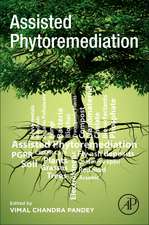Bio-Inspired Land Remediation: Environmental Contamination Remediation and Management
Editat de Vimal Chandra Pandeyen Limba Engleză Hardback – 3 ian 2023
| Toate formatele și edițiile | Preț | Express |
|---|---|---|
| Paperback (1) | 899.87 lei 43-57 zile | |
| Springer International Publishing – 4 ian 2024 | 899.87 lei 43-57 zile | |
| Hardback (1) | 905.98 lei 43-57 zile | |
| Springer International Publishing – 3 ian 2023 | 905.98 lei 43-57 zile |
Preț: 905.98 lei
Preț vechi: 1104.85 lei
-18% Nou
Puncte Express: 1359
Preț estimativ în valută:
173.38€ • 179.98$ • 144.57£
173.38€ • 179.98$ • 144.57£
Carte tipărită la comandă
Livrare economică 24 martie-07 aprilie
Preluare comenzi: 021 569.72.76
Specificații
ISBN-13: 9783031049309
ISBN-10: 3031049306
Pagini: 478
Ilustrații: XXIII, 478 p. 54 illus., 49 illus. in color.
Dimensiuni: 155 x 235 mm
Greutate: 0.88 kg
Ediția:1st ed. 2023
Editura: Springer International Publishing
Colecția Springer
Seria Environmental Contamination Remediation and Management
Locul publicării:Cham, Switzerland
ISBN-10: 3031049306
Pagini: 478
Ilustrații: XXIII, 478 p. 54 illus., 49 illus. in color.
Dimensiuni: 155 x 235 mm
Greutate: 0.88 kg
Ediția:1st ed. 2023
Editura: Springer International Publishing
Colecția Springer
Seria Environmental Contamination Remediation and Management
Locul publicării:Cham, Switzerland
Cuprins
1. Bioenergy crop-based ecological restoration of degraded lands.- 2. Understanding the role of ruderal plant species in restoration of degraded lands.- 3. Utilizing polluted lands for growing crops.- 4. Plant Assisted Bioremediation of Heavy Metal Polluted Soils.- 5. Cutting-edge tools to access microbial diversity and their function in land remediation.- 6. Endophytic microbes and their role in land remediation.- 7. Fungal-based land remediation.- 8. Microbial detoxification of contaminated land.- 9. Vermi-remediation of metal(loid)s contaminated surfaces.- 10. Fly ash Management through Vermiremediation.- 11. Management of biomass residues using vermicomposting approach.- 12. Vermiremediation of agrochemicals, PAHs and crude oil polluted land.- 13. Biochar-based remediation of heavy metal polluted land.- 14. Soil carbon sequestration strategies: Application of biochar an option to combat global warming.- 15. Remediation of pharmaceutical and personal care products in soil using Biochar.- 16. Biochar for improvement of soil properties.- 17. Biochar production and its impact on sustainable agriculture.
Notă biografică
Dr. Vimal Chandra Pandey featured in the world's top 2% scientists curated by Stanford University, United States. Dr. Pandey is a leading researcher in the field of environmental engineering, particularly phytomanagement of polluted sites/post-industrial lands. He has published more than 100 scientific articles/book chapters in peer-reviewed journals/books. He is also the author and editor of several books published by Elsevier, with several more forthcoming. Dr. Pandey is Associate Editor/Editor/Board Member of the prestigious journals Land Degradation and Development; Restoration Ecology; Ecological Processes; Environment, Development and Sustainability; Ambio; Environmental Management; and Bulletin of Environmental Contamination and Toxicology by Wiley/Springer.
Textul de pe ultima copertă
Land is fundamental to the human life. The upper layer of land is a non-renewable resource, and source of food. Therefore, land health is essential to long-term food security and to promote sustainable livelihoods. On account of urbanization, industrialization and population growth, land pollution is one of the major issues worldwide. As a result, land pollution is continuing across the world, and has been linked with a wide range of potentially toxic contaminants at rates that deteriorate land quality. Land pollution can result either anthropogenic activities or natural activities. The major contaminants of land pollution are metalloids, petroleum hydrocarbon, radioactive elements, polyaromatic hydrocarbons (PAHs), Pesticide, other organic pollutants, etc. that comes from different types of sources. In urban and peri-urban areas, irrigation of agricultural land with polluted water is also a reason of land pollution. Therefore, land security is an important issue for future sustainability. Its remediation and management are important issue worldwide to protect land quality and functions. Land pollution means degradation of earth's surface. Polluted land comes under the category of degraded land. Hence, the remediation of polluted land is essential for regaining biodiversity and ecosystems services and thereby achieving United Nations-Sustainable Development Goals (UN-SDGs).This fact showed the need to develop research into land remediation. Bio-inspired land remediation has undergone a huge development. Therefore, Biomanagement has a lot of potential to secure upper earth’s surface through the land remediation programs targeted during the United Nations Decade on Ecosystem Restoration (2021-2030). This book explores the remediation of land pollution that includes Phytoremediation, Bioremediation (bacterial remediation and fungal remediation), Vermiremediation, Biochar-based remediation and other Bio-inspired remediation. This book will be a remarkable asset for research scholars, environmentalists, ecological scientist, agriculturist, practitioners, policy makers, entrepreneurs, and other stakeholders alike.
Caracteristici
Explores examples of Bio-inspired remediation of land pollution from around the globe Provides readers with eco-friendly and cost-effective solutions to decontaminate land Covers the maximum bio-inspired land remediation approaches that is not explored in other books


































